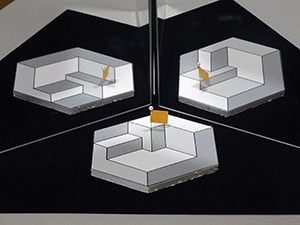To the lecture series English top page
Comments on Lecture 14 "Triply Ambiguous Objects"
Comment 1. Unnaturalness caused by a large picture
 A triply ambiguous object is created using an orthographically projected picture of a rectangular polyhedron. It is recommended to use a relatively small picture. A larger picture may make the object a little unnatural.
A triply ambiguous object is created using an orthographically projected picture of a rectangular polyhedron. It is recommended to use a relatively small picture. A larger picture may make the object a little unnatural.
The left image represents a triply ambiguous object created using a relatively large picture. The upper part of the object seems to be unnaturally smaller. This is because the vertical edges are not perceived as exactly vertical, but are perceived as slanted toward the center.
This unnatural appearance comes from the nature of the perspective projection. The upper part of the object appears to be small because that part is physically farther from the viewer than the lower part, but the peceived object is not so far as the actual distance. This discrepancy between the distance of the actual object and that of the perceived object creates this unnatural appearance. If we use a smaller picture, the discrepancy will be less visible, and consequently the preceived object becomes more natural.
Comment 2. Know-hows for designing triply ambiguous objects
Triply ambiguous objects are just 2D pictures with additional 3D objects such as flags. So anyone can create them easily. However, there are some know-hows to create less discomfort objects. The following are main of them.
(1) Use a projected picture of a rectangular object, i.e., a polyhedron whose faces are connected by right angles.
(2) Use an orthographic projection instead of a central projectjion. (A central projection may create a more natural appearance when we see the resulting object directly. However, the mirror image becomes unnatural in the sense that it does not obey the rules of perspective projecton.)
(3) Choose the direction of the projectin such that the three groups of parallel lines form 120-degree angles. (This makes it easier to adjust the orientatoin of the mirrors.)
(4) The orientations of the mirrors should be adjusted so that one group of parallel lines becomes vertical in the retina of the viewer.
(5) Choose a rectangular object such that all the three appearances give stable postures of the objects according to the gravity.
(6) Additonal 3D objects should be supported by narrow poles, and they are placed at convex vertices of the rectangular object. (Otherwise, they become inconsistent with respect to the direction of the gravity.)
(7) Use a small picture, and place the camera in a far distance. (This can avoid inconsistency in terms of the characteristics of the perspective projection.)
 A triply ambiguous object is created using an orthographically projected picture of a rectangular polyhedron. It is recommended to use a relatively small picture. A larger picture may make the object a little unnatural.
A triply ambiguous object is created using an orthographically projected picture of a rectangular polyhedron. It is recommended to use a relatively small picture. A larger picture may make the object a little unnatural.